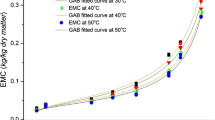Abstract
The aim of this study was to investigate the moisture sorption isotherms and the effect of storage on the quality of extruded snacks packed in low-density polythene and aluminium-laminated polythene at ambient (51 ± 1%, Relative humidity and 30 ± 1 °C, temperature) storage conditions. Moisture sorption isotherms were determined at temperature range 25–45 °C and relative humidity from 11 to 84% using the standard gravimetric static method. The experimental data were analyzed using five model equations such as GAB, Oswin, Smith, Caurie, and Halsey. The sorption isotherms for extruded product exhibited sigmoid curve of type II behavior and were found to be decreased with increasing temperature. The GAB, Oswin, Smith, and Caurie models were found to be the most suitable for describing the sorption curves. Storage stability in terms of quality parameters such as moisture content, lateral expansion, bulk density, hardness, color and sensory characteristics was assessed in both pouches. The extruded snack packed in low-density polythene pouches showed greater changes to quality parameters in comparison to aluminium-laminated pouches during storage. Therefore, it was suggested that aluminium-laminated pouches can store extruded product for a longer time period than low-density polythene pouches.






Similar content being viewed by others
References
Satia JA, Kristal AR, Patterson RE, Neuhouser ML, Trudeau E (2002) Psychosocial factors and dietary habits associated with vegetable consumption. Nutrition 18:247–254
Chotimarkorn C, Silalai N (2007) Oxidative stability of fried dough from rice flour containing rice bran powder during storage. LWT Food Sci Technol 41:561–568
Kahlon TS, Chow FI, Sayre RN (1994) Cholesterol lowering properties of rice bran. Cereal Foods World 39:99–103
Saunders RM (1990) The properties of rice bran as a food stuff. Cereal Foods World 35:632–635
Wells JH (1993) Utilization of rice bran & oil in human diets. La Agric 36:4–8
Jiang Y, Wang T (2005) Phytosterols in cereal by products. J Am Oil Chem Soc 82:439–444
Piironen V, Lindsay DG, Miettinen TA, Toivo J, Lampi AM (2000) Plant sterols: biosynthesis, biological function and their importance to human nutrition. J Sci Food Agric 80:939–966
Hu W, Wells JH, Tai-Sun S, Godber JS (1996) Comparison of isopropanol and hexane for extraction of vitamin E and oryzanols from stabilized rice bran. J Am Oil Chem Soc 73:1653–1656
Sharma R, Srivastava T, Saxena DC (2017) Effects of different process and machine parameters on physical properties of rice flour, corn flour and deoiled rice bran extruded product. Curr Nutr Food Sci 13:219–226
Ngoddy PO, Bakker-Arkema FW (1975) A theory of sorption hysteresis in biological materials. J Agric Eng Res 20:109–121
Samapundo S, Devlieghere F, De Meulenaer B, Debevere JM (2007) Sorption isotherms and isosteric heats of sorption of whole yellow dent corn. J Food Eng 79:168–175
Jamali A, Kouhila M, Mohamed LA, Jaouhari JT, Idlimam A, Abdenouri N (2006) Sorption isotherms of Chenopodium ambrosioides leaves at three temperatures. J Food Eng 72:77–84
Spiess WEL, Wolf W (1987) Critical evaluation of methods to determine moisture sorption isotherms. In: Rockland LB, Beuchat LR (eds) Water activity: theory and applications to food. Marcel Dekker, New York, pp 215–233
Bizot H, Riou N, Multon JL (1987) Practical guide for the determination of sorption isotherms and water activity. Sci Food
Greenspan L (1977) Humidity fixed points of binary saturated aqueous solutions. J Res Natl Bureau Stand Sect A Phys Chem 81A:89–96
Rizvi SSH (1986) Thermodynamic properties of food in dehydration. In: Rao MA, Rizvi SSH, Datta AK, Ahmed J (eds) Engineering properties of foods. Marcel Dekker, New York, pp 133–214
Young JF (1967) Humidity control in the laboratory using salt solutions, a review. J Appl Chem 17:241–245
Singh Y, Prasad K (2015) Sorption isotherms modeling approach of rice-based instant soup mix stored under controlled temperature and humidity. Cogent Food Agric 1:2–11
Van den Berg C, Bruin S (1981) Water activity and its estimation in food systems: theoretical aspects. In: Rockland LB, Stewart GF (eds) Water activity: influences on food quality. Academic Press, New York, pp 1–61
Smith SE (1947) The sorption of water vapour by high polymers. J Am Chem Soc 69:646
Caurie M (1970) A new model equation for predicting safe storage moisture level for optimum stability of dehydrated foods. J Food Technol 5:301–307
Oswin CR (1946) The kinetics of package life III. The isotherm. J Soc Chem Ind 65:419–421
Halsey G (1948) Physical adsorption on non-uniform surfaces. J Chem Phys 16:931–937
AACC (2000) Approved methods of American Association of Cereal Chemists, 10th edn. The Association, St. Paul
Meng X, Threinen D, Hansen M, Driedger D (2010) Effects of extrusion conditions on system parameters and physical properties of chick pea flour based snack. Food Res Int 43:650–658
Stojceska V, Ainsworth P, Plunkett A, Ibanoglu E, Ibanoglu S (2008) Cauliflower by-products as a new source of dietary fibre, antioxidants and proteins in cereal based ready-to-eat expanded snacks. J Food Eng 87:554–563
Singh D, Chauhan G, Tyagi SM, Suresh I (2000) Extruded snacks from composite of rice brokens and wheat bran. J Food Sci Technol 37:1–5
Brunauer S, Emmett PH, Teller E (1938) Adsorption of gases in multimolecular layers. J Am Chem Soc 60:309–319
Kaya S, Kahyaoglu T (2007) Moisture sorption and thermodynamic properties of safflower petals and tarragon. J Food Eng 78:413–421
Arslan N, Togrul H (2005) The fitting of various models to water sorption isotherms of tea stored in a chamber under controlled temperature and humidity. J Stored Prod Res 42:112–135
Bahloul N, Boudhrioua N, Kechaou N (2008) Moisture desorption–adsorption isotherms and isosteric heats of sorption of Tunisian olive leaves (Olea europaea L.). Ind Crops Prod 28:162–176
Mazza G, Le Maguer M (1980) Dehydration of onion. Some theoretical and practical considerations. J Food Technol 15:181–194
Iglesias HA, Chirife J, Viollaz P (1976) Thermodynamics of water vapour sorption by sugar beet root. J Food Technol 11:91–101
Palipane KB, Driscoll RH (1992) Moisture sorption characteristics of inshell macadamia nuts. J Food Eng 18:63–76
Wani SA, Solanke N, Kumar P (2015) Extruded product based on oat and fenugreek and their storage stability. Curr Nutr Food Sci 11:78–84
Kuna A, Devi NL, Kalpana K (2013) Utilization of fish powder in ready-to-eat extruded snacks. Fish Technol 50:245–250
Baraiya KG, Zofair SM, Mulye VB, Lende SR, Khileri RA, Kadri RM, Jha AK, Patel MR (2016) Development and storage characteristics of shrimp (Solenocera crassicornis) based snack food using extrusion technology. J Appl Nat Sci 8(3):1366–1374
Kerekreti D (1980) Regulation of moisture, bulk density, particle size and wettability of dried milk. Prumysl Potravin 31:327–334
Chauhan AK, Patil V (2013) Effect of packaging material on storage ability of mango milk powder and the quality of reconstituted mango milk drink. Powder Technol 239:86–93
Smithey SL, Huff HE, Hsieh F (1995) Processing parameters and product properties of extruded beef and nonmeat cereal binders. LWT Food Sci Technol 28:386–394
Kumar N, Sarkar BC, Sharma HK, Jha SK (2012) Colour kinetics and storage characteristics of carrot, pulse and rice by-product based extrudates. Br Food J 114:1279–1296
Dar AH, Sharma HK, Kumar N (2014) Effect of extrusion temperature on the microstructure, textural and functional attributes of carrot pomace-based extrudates. J Food Process Preserv 38(1):212–222
Rai S, Chauhan AS (2008) Quality attributes of drum dried papaya cereal flakes developed from ripe papaya (Carica papaya L.). Electron J Environ Agric Food Chem 7:2914–2931
Muralikrishna M, Nanjundaswamy AM, Siddappa GS (1969) Guava powder-preparation, packaging and storage studies. J Food Sci Technol 6:93–98
Yu SC, Lin PC, Lin J (2011) Effects of extrusion processing condition on the physico-chemical properties of mungbean extrudates. In: Proceedings of the 12th Asian food conference, Bangkok, pp 524–526
Gulla S, Waghray K (2012) Blending of oils: a case study on storage stability and sensory characteristics of a ready to eat extruded snack. J Diet Food Sci 2(1):1–2
Acknowledgements
We gratefully acknowledge the I.K.G. Punjab Technical University, Jalandhar, Punjab for providing the required facilities to carry out the research work.
Author information
Authors and Affiliations
Corresponding author
Rights and permissions
About this article
Cite this article
Sharma, R., Srivastava, T. & Saxena, D.C. Moisture Sorption Isotherm Modeling Approach and Effect of Packaging Material on Quality Changes in Extruded Product Stored Under Controlled Conditions. J Package Technol Res 3, 57–65 (2019). https://doi.org/10.1007/s41783-018-0052-3
Received:
Accepted:
Published:
Issue Date:
DOI: https://doi.org/10.1007/s41783-018-0052-3




